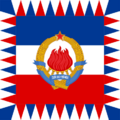President of Yugoslavia facts for kids
Quick facts for kids President of the Socialist Federal Republic of Yugoslavia |
|
|---|---|

Standard of the President
|
|
| Residence | White Palace, Belgrade |
| Appointer | Federal Assembly of SFR Yugoslavia |
| Term length | Unlimited |
| Precursor | President of the Presidium of the National Assembly |
| Formation | 14 January 1953 |
| First holder | Josip Broz Tito |
| Final holder | Josip Broz Tito |
| Abolished | 4 May 1980 |
| Succession | President of the Presidency |
The President of the Socialist Federal Republic of Yugoslavia was the country's top leader, like a head of state. This important job existed from January 14, 1953, to May 4, 1980. Only one person ever held this position: Josip Broz Tito. He was also the leader of the main political party, the League of Communists of Yugoslavia. Tito was eventually made "president for life." After he passed away in 1980, the role of President ended. A new leadership group, called the Presidency of Yugoslavia, took its place.
Contents
How the Role of President Began
Before 1953, Yugoslavia's government was led by a "prime minister." Josip Broz Tito was this prime minister. The country's first constitution in 1946 set up this system.
Changes in 1953
In 1953, a new constitution was created. This law officially called Yugoslavia a "socialist republic." It changed the government structure. The job of "prime minister" was replaced by the "President." This new President would be the head of state. They would also lead a group called the Federal Executive Council (FEC). The FEC was like a cabinet, with 30 to 40 members.
On January 14, 1953, Tito became President. He was re-elected several times after that.
Further Changes to the Presidency
More changes came with the 1963 constitution. This new law allowed Tito to serve as President for an unlimited number of terms. It also created a separate role for the head of the Federal Executive Council. This meant the President no longer directly led the FEC.
However, Tito remained the head of state. He was also the commander-in-chief of the Yugoslav People's Army. Plus, he continued to lead the communist party. He was re-elected again in 1963 and 1968 under this system.
The President for Life
In 1971, the constitution was changed again. A new group called the collective presidency was formed. This group included representatives from different parts of Yugoslavia. The President of the Republic still led this group.
The 1974 constitution made an even bigger change. It gave Tito, who was 82 at the time, an unlimited term. This officially made him "president-for-life." This constitution also planned for what would happen after Tito. It created a new "rotating" job called the President of the Presidency. This role would start after Tito's death. The person who was the vice president of the Presidency would take over.
This plan happened on May 4, 1980, when Tito passed away. Lazar Koliševski became the first President of the Presidency.
Josip Broz Tito: The Only President
League of Communists of Yugoslavia (SKJ)
| No. | President | Took office | Left office | Time in office | Party | |
|---|---|---|---|---|---|---|
| 1 | Marshal of Yugoslavia Josip Broz Tito (1892–1980) |
14 January 1953 | 4 May 1980 † | 27 years, 111 days | SKJ |
Josip Broz Tito was the only person to hold the title of President of the Socialist Federal Republic of Yugoslavia. He served in this role for 27 years, from 1953 until his death in 1980. During his time, he was a very powerful and important figure in Yugoslavia and in the world.
See also
- President of the Presidency of Yugoslavia
- List of heads of state of Yugoslavia



